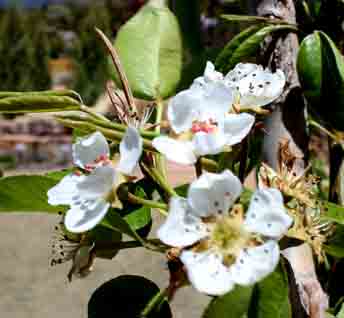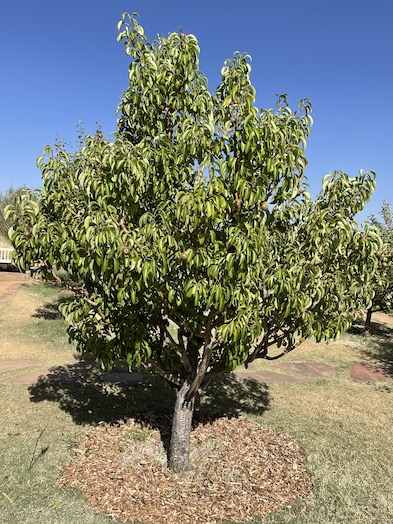The Tree
 |
 |
|---|---|
The Flowers |
Immature Fruit |
Description
"The pear is native to coastal and mildly temperate regions of the Old World, from western Europe and north Africa east right across Asia. It is a medium-sized tree, reaching 10–17 metres (33–56 ft) tall, often with a tall, narrow crown; a few species are shrubby.
The leaves are alternately arranged, simple, 2–12 centimetres (0.79–4.72 in) long, glossy green on some species, densely silvery-hairy in some others; leaf shape varies from broad oval to narrow lanceolate. Most pears are deciduous, but one or two species in southeast Asia are evergreen. Most are cold-hardy, withstanding temperatures between −25 °C (−13 °F) and −40 °C (−40 °F) in winter, except for the evergreen species, which only tolerate temperatures down to about −15 °C (5 °F).
The flowers are white, rarely tinted yellow or pink, 2–4 centimetres (0.79–1.57 in) diameter, and have five petals.[2] Like that of the related apple, the pear fruit is a pome, in most wild species 1–4 centimetres (0.39–1.57 in) diameter, but in some cultivated forms up to 18 centimetres (7.1 in) long and 8 centimetres (3.1 in) broad; the shape varies in most species from oblate or globose, to the classic pyriform 'pear-shape' of the European pear with an elongated basal portion and a bulbous end.
The fruit is composed of the receptacle or upper end of the flower-stalk (the so-called calyx tube) greatly dilated. Enclosed within its cellular flesh is the true fruit: five cartilaginous carpels, known colloquially as the "core". From the upper rim of the receptacle are given off the five sepals,[vague] the five petals, and the very numerous stamens.
Pears and apples cannot always be distinguished by the form of the fruit;[3] some pears look very much like some apples, e.g. the nashi pear. One major difference is that the flesh of pear fruit contains stone cells (also called "grit")." (Wikipedia)
Internet Resource
